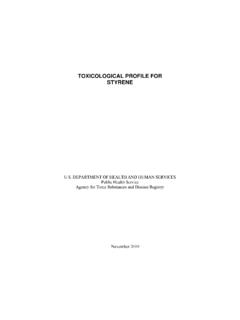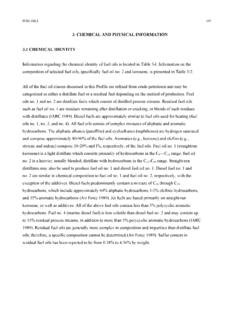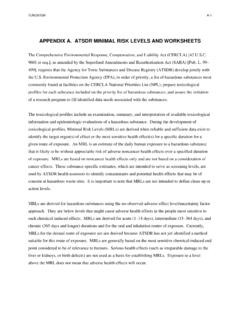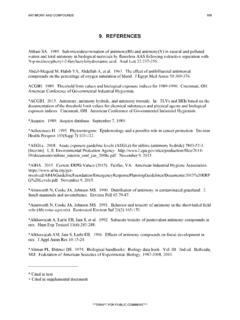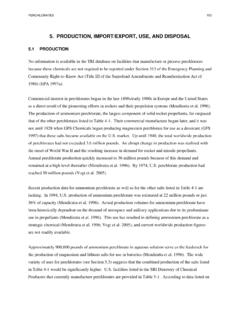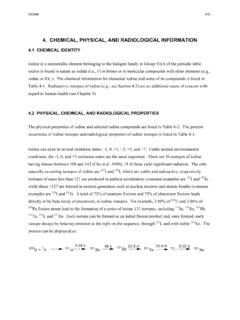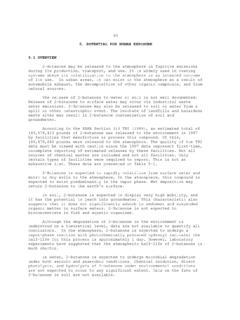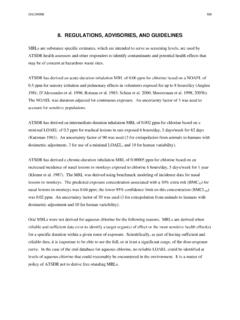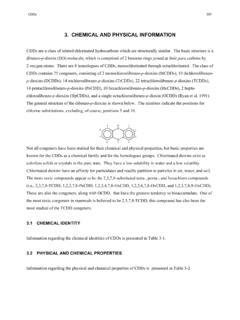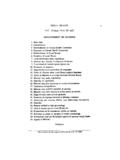Transcription of STODDARD SOLVENT - atsdr.cdc.gov
1 STODDARD SOLVENT 1. 1. PUBLIC health STATEMENT. This Statement was prepared to give you information about STODDARD SOLVENT and toemphasize the human health effects that may result from exposure to it. The Environmental Protection Agency (EPA) has identified 1,397 sites on its National Priorities List (NPL). STODDARD SOLVENT has been found in at least seven of these sites. However, we do not know how many of the 1,397 NPL sites have been evaluated for STODDARD SOLVENT . As EPA evaluates more sites, the number of sites at which STODDARD SOLVENT is found may change. This information is important for you to know because STODDARD SOLVENT may cause harmful health effects and because these sites are potential or actual sources of human exposure to STODDARD SOLVENT .
2 When a chemical is released from a large area, such as an industrial plant, or from a container, such as a drum or bottle, it enters the environment as a chemical emission. This emission, which is also called a release, does not always lead to exposure. You can be exposed to a chemical only when you come into contact with the chemical. You may be exposed to it in the environment by breathing, eating, or drinking substances containing the chemical or by skin contact with it. If you are exposed to a hazardous chemical such as STODDARD SOLVENT , several factors will determine whether harmful health effects will occur and what the type and severity of those health effects will be.
3 These factors include the dose (how much), the duration (how long), the route or pathway by which you are exposed (breathing, eating, drinking, or skin contact), the other chemicals to which you are exposed, and your individual characteristics such as age, sex, nutritional status, family traits, life-style, and state of health . STODDARD SOLVENT 2. 1. publlc health STATEMENT. WHAT IS STODDARD SOLVENT ? STODDARD SOLVENT is a widely used, man-made organic SOLVENT that comes from the refining of crude oil. It is a petroleum mixture made from distilled alkanes, cycloalkanes (naphthenes), and aromatic compounds.
4 The chemicals in STODDARD SOLVENT are similar to those in white spirits, which are also discussed in this profile. STODDARD SOLVENT is commonly referred to as dry cleaning safety SOLVENT , naphtha safety SOLVENT , petroleum SOLVENT , PD-680, varnoline, and spotting naphtha. It also goes by the registered trade names Texsolve S and Varsol 1. STODDARD SOLVENT is used as a paint thinner, as a SOLVENT in some types of photocopier toners, in some types of printing inks, in some adhesives, as a dry cleaning sollvent, and as a general cleaner and degreaser. It is produced and used as a colorless, flammable liquid but will turn into a vapor (gas) at temperatures ranging from 150-200 C.
5 STODDARD SOLVENT smells and tastes like kerosene. You can smell it when the level in the air is about parts of STODDARD SOLVENT in a million parts of air (ppm) or 2 milligrams of STODDARD SOLVENT per cubic meter of air (mg/m3). See Chapters 3 and 4 for more information on the physical and chemical properties of STODDARD SOLVENT and how it is produced and used. WHAT HAPPENS TO STODDARD SOLVENT WHEN IT ENTERS THE. ENVIRONMENT? STODDARD SOLVENT is a mixture of many chemicals. Some of these evaporate into the air when STODDARD SOLVENT spills onto soils or surface waters.
6 These chemicals may be broken down by sunlight or by other chemicals in the air. Also, some of these chemicals may sorb (attach) to organic matter. STODDARD SOLVENT itself does not dissolve well in water, but some of the chemicals in it do dissolve when it spills on surface water or when it leaks from underground storage tanks. Some of the chemicals in STODDARD SOLVENT can attach to particles soil or water and, in water, may sink down to the sediment. In water, soil, or sediment, microorganisms may break down the chemicals (a process known as biodegradation). Although some of the chemicals that make up STODDARD SOLVENT can attach to organic matter in the soil, if a large amount of STODDARD SOLVENT contaminates the soil, it will move through the soil into groundwater.
7 It is not known whether STODDARD SOLVENT will accumulate in plants STODDARD SOLVENT 3. 1. PUBLIC health STATEMENT. or animals living in contaminated soil or water, or in animals eating contaminated plants or sediments. However, some of the chemicals that make up the STODDARD SOLVENT mixture might accumulate in these situations, depending upon the type of chemical. Generally, smaller alkanes do not tend to bioaccumulate, while aromatics and larger alkanes, including some cycloalkanes, tend to bioaccumulate. See Chapter 5 for more information on what happens to STODDARD SOLVENT when it enters the environment.
8 HOW MIGHT I BE EXPOSED TO STODDARD SOLVENT ? You are most likely to be exposed to STODDARD SOLVENT if you use a product, such as paint or a paint thinner, that contains it and the vapors get in your lungs or eyes. If you work in an industry that uses or produces dry cleaning fluid, paints, coatings, waxes, or equipment cleaning fluid with STODDARD SOLVENT in it, you may breathe in some of the components of STODDARD SOLVENT that evaporate into the air. You may be exposed to STODDARD SOLVENT if you breathe air that contains STODDARD SOLVENT after it has entered the atmosphere from a dry cleaning plant or spilled or leaked onto soils or surface water.
9 When it is spilled, the different components that make up STODDARD SOLVENT will react differently in the different media of the environment (for example, in soil, water, or air). So, if you become exposed, you are no longer being exposed to a single compound called STODDARD SOLVENT but rather to its components. You would only breathe the components that evaporate into the air. If STODDARD SOLVENT has contaminated groundwater, you may be exposed if you drink this water or use it for bathing or washing. If you use products that contain STODDARD SOLVENT and do not wear protective clothing, you may be exposed if it gets on your skin.
10 Humans may be exposed to STODDARD SOLVENT near hazardous waste sites, but it is not known how many are being exposed. It is unclear what routes of exposure are most significant at hazardous waste sites. It is likely that you might be exposed to STODDARD SOLVENT near a hazardous waste site by breathing it in the air. Although some compounds in STODDARD SOLVENT evaporate quickly, you may be continually exposed near hazardous waste sites if the material is leaking from buried or above-ground drums or is slowly moving through the soil STODDARD SOLVENT 4. 1. PUBLIC health STATEMENT.
